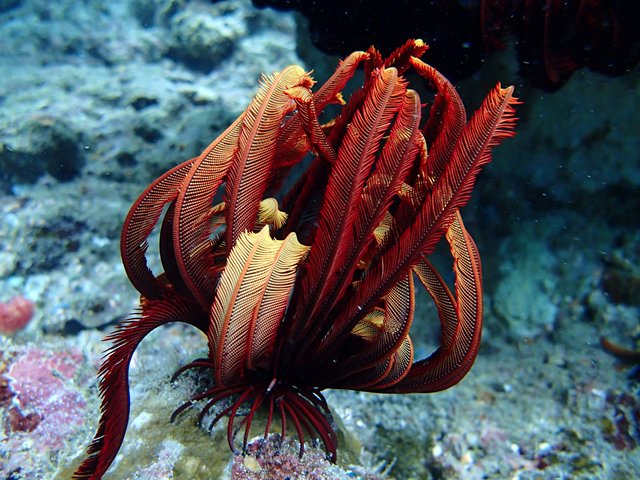We’re told that Ambon is looking for a moniker. We met a woman who had worked to promote Ambon as a tourist destination, who said there was some tension between the candidate slogans of “city of music” and “the waterfront city.” We’re not sure how well either of those apply, because for us Ambon will be remembered as “the city of delicious food”.
There was plenty of time to find local haunts, and we had incredible meals at the little
rumah makan (restaurants) near the city market.
Arranging fish servings for the window display
I seem to have a lot of photos like this one, capturing the a great spread just before we attack it. These restaurants actually put all of their dishes on your table, then only charge you for those you eat. Dangerous.
Indonesian food is amazing. Oh my goodness, it is just delicious.
We had to try the Muluku staple called
pepeda, a porridge goo made from sago (which is made from the pounded heart of tree trunks- hungry yet?). Our new shoreside family made dinner for us one evening so that we could try it along with a range of regional dishes. It’s a good thing we had the other dishes, because pepeda- as one of our shoreside fam referred to it- has all the eating qualities of glue. But the rest? Amazing. Fresh fish with a spicy soy sauce, a heavily spiced fish stew, and more.
Local treats from pepeda (sago mush) to ikan kuah kuning (fish in a turmeric/almond stew)
Here's a charming image of the
glue pepeda. Mmmm. Trees.
Some indulgences were decidedly less local. At the fancypants mall, the kids inhaled bowls of frozen yogurt. Mmmm…. And then we discovered that the Indonesian restaurant upstairs made chocolate milkshakes and French fries. Trouble!
I was lucky to have another very memorable cooking lesson on board Totem. A conversation with a new friend about how nutmeg is used for savory cooking turned into a lazy weekend afternoon extravaganza on Totem (with their extended family, natch) so they could provide hands-on instruction. Our recipe: Babi Kecap, pork in a rich sauce. It’s somewhat unusual in that pork is less commonly eaten in this predominantly Muslim country, but this region has a significant Christian population...although it took some work to track down the pork. I did the grocery shopping, they brought the knowledge (and their families), and we made a day of it. More, please!
My fantastic cooking teachers, Ina and Erlyna
Babi Kecap
2 kg fatty pork (you do not buy "cuts" in the public market. You get a lump of meat)
~ 1/3 c kecap manis (sweet Indonesian soy sauce: sorry, no substitute)
1 Tbsp soy sauce
Salt, oil
~20 cloves garlic
1 med yellow onion
1 bunch green onions / scallions
1 to 2 whole nutmegs
Wash pork, drain well, and cut it into bit-sized pieces. Set aside in a bowl. Add about a tablespoon each of kecap manis and soy sauce, a generous pinch of salt, and about 10 cloves of minced garlic. Stir and let stand for 15-30 minutes.
Chop half of onion and mince 10 cloves of garlic. Fry in a bit of oil (we used coconut) until fragrant, then add pork. Grate in lots of nutmeg- we used about half of a large nut- than splash on a couple of tablespoons of kecap manis. Eventually this will color the sauce to a dark brown color.
Stir over medium heat. My cooking teachers periodically added a bit more kecap manis until they were satisfied with the color and quantity of the sauce. As the pork cooked and rendered fat, this became like a very dark runny caramel.
When pork is nearly done, grate in more nutmeg- we used almost a whole clove. When it is tender and nearly complete, add the other half of the onion (rough chopped into crescent slivers) and scallions (chopped). Cook until these are wilted and mixed in. Cool slightly, then serve with rice.
We ate the entire batch before I could get an "after" photo, and trust me, "before" photos of raw pork just aren't that exciting. I’m told this is even more delicious the second day, but we haven’t made it last that long yet!
Ina, Erlyna and relatives heading home after our afternoon on Totem



















































